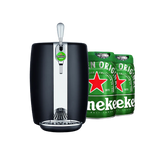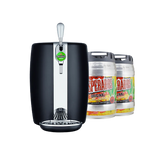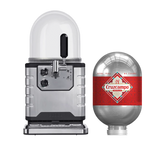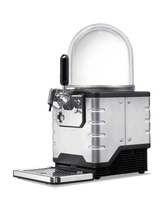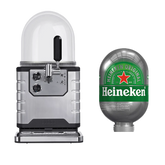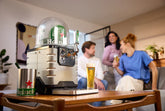DIY Building a Home Bar Checklist - Dimensions, Materials & More
Where do you start with building a bar at home?
Whether you’re looking to create a bar in your man cave that houses the perfect pint, or want to convert your shed into a certified boozer, there are quite a few considerations that you need to be aware of prior to jumping in at the deep end of a proverbial pint glass.
Whilst any project is naturally going to be fully bespoke to your requirements, there are guidelines or checklists you can follow to stay on track, and guide you in the right direction if you don’t know which point to take next.
Below, we’ve put together our guide to building a home bar, including aspects such as dimensions, ideas on placements, decorations, and even what to think about with designing the space (and realistically being able to get your project off the ground). Let’s get stuck in!
Home Bar Build – Checklist & What you need to know
Where is your bar going to go?
This one sounds obvious, but you need to seriously think (and plan) exactly where your home bar will go, prior to purchasing the necessary materials and items for building it. The last thing you want is to spend a week’s worth of time in B&Q, only to find out that none of the necessities will actually fit in your desired spot.
Whether your bad is going inside an existing structure like the home, garage or shed, or if you’re purposely buying an outhouse or man cave dwelling for the purpose of bar, it’s crucial that you accurately measure and document the measurements of the area you’ll be building on.
You’ll also need to think about the height of the bar in an outdoor structure e.g. are you opting for a sloped or flat roof? Is it going to be so tall that the neighbours call the cancel and think you’ve genuinely opened a pub in the back garden?
Measuring and planning accurately is such an important aspect of any home build, so get this aspect right and you’re already halfway to pouring the first pint from your chapel of tipple.

Designing your bar
Where do you start when it actually comes to designing your home bar? Well, the options are endless, but let’s look at some of the main ones that you need to be aware of…
The location for your home bar will have a major influence on the design of it. Where you put it in your home can really affect what type of home bar ideas you come up with. We’ve already mentioned it above, but just to summarise some of the most popular places for a home bar build and what you need to be aware of:
Here are some of the main places where people choose to put their home bars:
- Conservatory
- Garage/shed
- Garden room/gazebo
- Under the stairs
- Atrium (large windows with an outside view)
- Kitchen diner combined
- The home office (space permitting!)
It’s quite likely that you already have somewhere in mind where you would like to place your home bar. But it might be worth thinking about the pros and cons of each home bar location. For example, a home bar in a conservatory will let you make use of natural light during the day, but some conservatories can get cold at night.
A home bar in a garage or garden room could be ideal if it’s going to be used on a regular basis throughout the year, but it might get too warm during the summer. And home bars in home offices can be a great way to utilise what would otherwise be wasted space, but you might find that your home office becomes a home bar too often!
You’ll also need to blueprint and design the layout of the bar once you’ve, at least initially, outlined the size and what needs to be in it. In terms of things to consider when designing your home bar, regardless of its location you need to think of things such as:
Hang-out space. Home bars are social hubs as much as they’re preparation spaces – think seating options for those hosting evening cocktails or less formal gatherings.
Lighting. Nowadays it’s easy enough to buy lamps that fit onto most home bar tables so hosts can sit back and enjoy their company….Or create a new one completely from scratch…definitely have more fun in the home bartending game if you can dig deep and give your home bar a fresh look.
Storage. The home bar is also where all of those cocktail accessories live; corkscrews for wine drinkers; shakers; spoons for stirring drinks – so consider how much storage space your home bar design will require
How your bar is going to safely have access to utilities is another really important aspect to consider.
Flooring. The flooring is quite important too; it needs to be home bar friendly, as in easy to wipe down and keep clean.
Choosing a wet or dry bar – which is better?
Ideally, the answer would be ‘let’s just build both’, but let’s be honest…who has the space for both? So, how do you decide on which type of bar to go for?
Why choose a wet home bar?
Wet bars are home bars that have a sink in them, attached or not. The main benefit is naturally actually having access to a regular source of water, rather than having to rely on an external source that isn’t wired-up every time you require a drink.
Why choose a dry home bar?
Dry home bars are home bars without sinks in them. You can fit more glasses into these kinds of home bars than wet home bars, but the problem comes when you want to wash your hands after mixing yourself cocktails!
Also, party hosts should be very wary of putting flammable substances like spirits near water sources – it could lead to an embarrassing situation if someone spills some while making drinks…
Home bar dimensions to be aware of
When looking for specific dimensions for your build, the answer can often be a bit of a ‘how long is a piece of string’, but there are some handy guidelines that I wish he had discovered when doing our first home bar build!
The standard rule is that your home bar needs to be at least 3 feet wide by 6.5 feet deep. This is to ensure that the home bar enough space so people can move around it comfortably, and also for your home entertainment equipment to fit in there nice and snugly without too much overlap or crowding.
The home bar stands at an average of 42-inches tall with about 36 inches of workable height if you’re planning on using stools for seating, but 40 inches would be better if you’re planning on standing while partaking from your home bar.
If you have a basement home theater then this size should be sufficient, unless you want a full wet bar complete with a sink and ice machine. If that’s the case then add another-2 feet to these dimensions.
You also have to take into account the overhang on the bar, which as standard can be anywhere from 4 to 16 inches.
In terms of stool dimensions, home bar stools should be at-least 22 inches high and 30 inches deep.
Make sure to factor in enough home bar storage space for your bar glasses, accessories, beer supplies and liquors. Keep in mind that this area is usually below the home bar so it won’t take up much valuable countertop real estate.
In terms of a definitive answer, what size should a home bar be?
Since home bars range in many different shapes and sizes there is no definitive answer to this question. One standard size would be 6.5 feet long by 3 feet wide–this will provide you with enough space for at least four people to comfortably stand around the home bar while giving you plenty of workable space behind it too.
The home bar should also be anywhere from 42 inches tall to give you enough room to store equipment underneath the countertop or prep work on top if needed too.
Choosing the right materials
Okay, so you’ve got your layout, your dimensions, you know what you’re going to start filling your bar with… now, what materials do you need to set about actually building it? Let’s have a look at some of the more common ones that you can easily get your hands on:
Oak
Oak is a classic home bar option, and easy to work with. However, it can add a lot of unwanted weight to the home bar if you’re not careful.
Maple
Maple is lighter than oak, but still has a ‘classic home bar feel’
Birch
Birch has more contemporary feel – it’s light enough not to weigh down your home bar, but also won’t break the bank either.
Plastic
It might sound odd for this list, but plastic furniture can be surprisingly heavy and durable. It’s great for home bars that need to be moved around often or transported between houses/apartments. The plastic can last anywhere from 20+ years before showing signs of wear and tear after plenty of use. It’s cheap, easy to work with and can be home made – so long as you have the tools available.
Metal
It might sound obvious but metal home bars are extremely durable and difficult to damage. However, they do tend to cost more than most other materials. They’re also very cold often times – something to consider if your home bar is going in a room without central heating or air conditioning.
Glass
Another material that isn’t always used for home bars, glass home bars can add a lovely aesthetic. Glass home bars aren’t too expensive either which makes them a great option for new home owners looking to build a stylish home bar on a budget. On the downside however, glass home bars don’t handle liquids very well – they’ll freeze up if you place them outside of a home bar.
Cork
You can’t beat homemade cork home bars for good looks, style and price. Cork home bars are easy to work with, don’t need expensive tools and cost next to nothing to make. The downside however is that cork home bars won’t last as long as other more durable home bar materials on this list.
They’re also not particularly great at handling heavy wear and tear i.e spilling drinks etc . Generally speaking, the better you take care of your home bar the longer it’s going to look new! With that in mind, let’s move on to the building phase. We recommend you check out our dedicated guide on how to build a home pub or bar for this aspect of the build!
Filling your newly-built bar with accessories
Ooh, if you thought the building part was fun, what about actually filling the bar with a load of accessories? Sure, your bank account will take a hit, but who can say no to a bunch of quirky home bar accessories or branded items with your name adorned across it?
Rather than give a list inside a list, you’d be better off having a look at our recent guides and product reviews on all the types of things you can fill your home bar with. We recommend you start with:
Questions we’re often asked about building a home bar
How much does a home bar cost to build?
If you're literally just building the bar and not refurbishing an entire room, you can look to gather material and accessories (plus the time spent on the building) for £1,000-£3,000. If you're looking to hire a contractor to renovate a room into a fully functioning home bar, then you'll be looking at significantly more.
Does a home bar add value to a home?
Yes! A study by remodeling magazine found that a home pub or home bar can indeed add value to your home.
Is building a pub at home worth it?
Only you can truly answer that question! What is a home bar or pub worth to you? Will you truly be getting the value out of it if you go ahead with a build?
